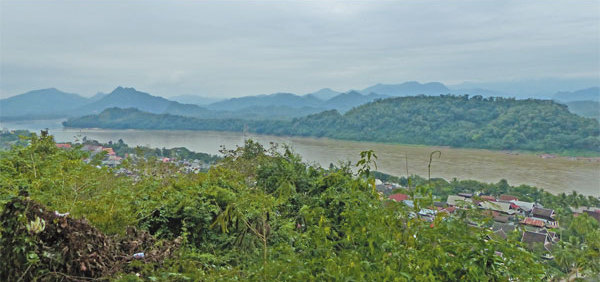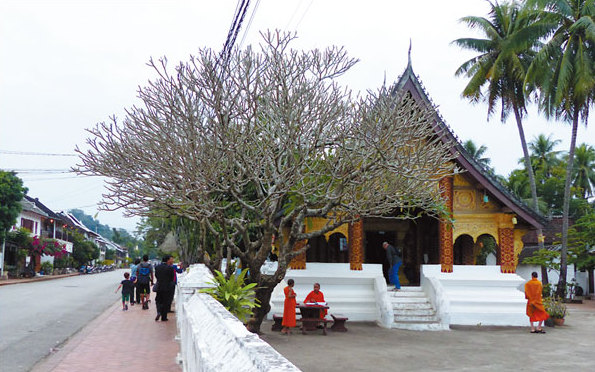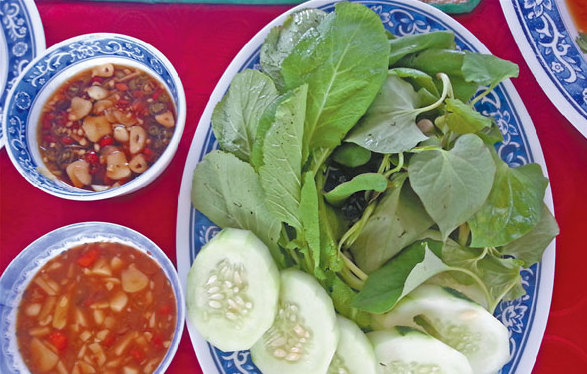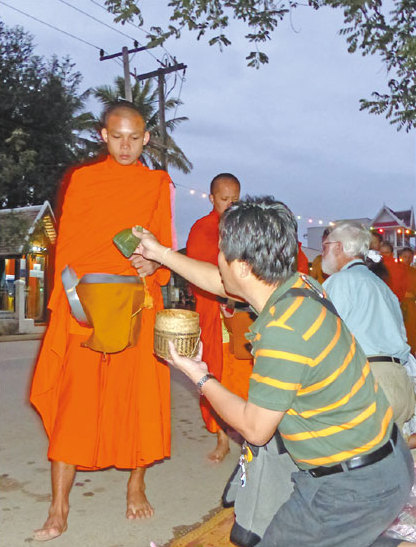City of good karma
Updated: 2013-12-22 07:15
By Wu Liping(China Daily)
|
|||||||||
It is a historical city surrounded by a beautiful natural cradle of green. Its people are contented. Their lives are simple and honest, and they feel blessed to be where they are. Wu Liping visits Luang Prabang in Laos.
Those who are born and bred in Luang Prabang City say they enjoy the good karma of doing good in their previous lives. Their city is an ancient one with a history of more than a thousand years, and is surrounded by a picturesque landscape of verdant mountains and an ecologically sound environment.
Nestled on the valley floor along the Mekong River, it was the royal capital until 1975, when the Laotian people gained independence from the monarchy. It is a city with ancient architecture, the more modern of which boasts French colonial influences from the 19th and 20th centuries.
|
Phousi Hill is located in the central area of Luang Prabang City. Its peak offers a panoramic view of the city and the Khan River. Photos by Wu Liping / China Daily |
|
Temples are constructed across from ordinary houses. |
|
Fresh herbs are popular on local tables. |
|
Monks receive offerings from devotees at a ceremony at dawn. |
The weather is pleasant, with temperatures hovering around 20 C in the day even during the coldest season. The folk customs are simple and honest. Smiling faces are everywhere.
Above all these secular features, this is a city of Buddhism, with more than 50 big temples and monasteries, and where almost every male citizen spends some time experiencing monastic life. More than 90 percent of its people are Buddhists.
Luang Prabang was listed as a UNESCO World Heritage Site in 1995 and is regarded as one of the most livable cities in the world.
We start our journey from Vientiane, the current capital of Laos, on an early morning in late November.
About 500 kilometers north, we reach the mountains, where the road is circuitous and sometimes bumpy. At dusk, it turns foggy and then drizzles, making the 8-hour journey another two hours longer. In the next two days, however, we are glad we persevered as we are rewarded with unexpected experiences.
Luang Prabang City is the capital of Luang Prabang Province, which is the core area of the north of the country, says Khamdua Yiakuanoheuvang, vice-secretary of the Provincial Party Committee of Luang Prabang Province.
Occupying an area of 20,000 square kilometers, the province has a population of 400,000 from 10 ethnic groups, who live harmoniously in the area.
According to Yiakuanoheuvang, tourism is the pillar of the province, especially in Luang Prabang City.
There are 229 scenic spots, including temples, a royal palace, mountains, waterfalls and caves, he says. The number of overseas tourists who arrive are about 300,000, while domestic tourists exceed 1 million.
Before 1975, there were only two hotels in the city. "Now we have 62," Yiakuanoheuvang says, adding that there are more than 300 hostels and nearly 300 restaurants.
We settled in the Phousi Hotel, in the center of the city.
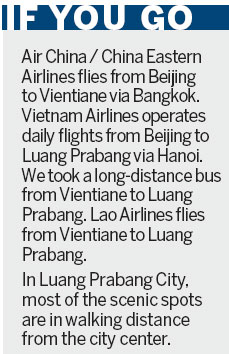
Just outside the hotel along the sidewalk, people can participate in or witness the alms-giving ceremony early every morning - a major tourist attraction. The religious practice is a living Buddhist tradition of the city and has great meaning for local people.
The street is relatively quiet around 5:30 am. Small groups of people linger along the sidewalk, waiting for the ritual.
The vendors of the morning market sell sticky rice, a staple food served in small bamboo baskets or stuffed into bamboo tubes. There are also bananas and other vegetarian food. Several electric motor cars, with a trailer for 6 to 8 passengers, break the quiet. They ferry in tourists who are staying far from the area to watch the ceremony.
At about 10 minutes to 6 am, the first procession of about 15 monks arrives from the east. They are led by a senior monk, who wears a peaceful smile on his face, with the young monks - seemingly ranked by age - following him. The youngest looks to be only about 15 years old.
They each carry a metal container on their shoulders. As they pass the devotees, they open the lids to receive the offerings. Within 20 minutes, another three teams of monks have arrived from different directions, their orange robes ablaze like rays of sunshine casting light on the town before dawn.
"A young man in Laos will become a monk at least once in his life," says Khammuong Oudomhak, head of the office at the Laos Journalists Association, and our guide.
"Some may devote their whole lives to Buddhism, but most choose to be a monk for years or just for several days. In Laos, the main aim of becoming a monk is to give thanks to mothers."
Becoming a monk and chanting the sutras will gather merits, and dedicating these merits to one's mother will bring blessings upon her.
Oudomhak tells us he had been a monk for 17 years.
"I became a monk under my mother's wish," he says. "When I grew older, I felt the goodness and calm that come from Buddhism."
Although Oudomhak, 64, has resumed secular life for nearly 40 years, he says he has benefited from the experience.
"It taught me the beauty of a simple life," he says. "Laotian people treat guests warmly and hope they can be as happy as we are."
In Luang Prabang, the religious and the secular live together harmoniously, which we can sense from the layout of the city. On some streets, temples are constructed all along one side of the street, while ordinary houses are on the opposite side of the road.
The doors of the temples are always open, inviting all to share the merits of sutra-chanting. The walls of the temples are shorter than shoulder height, all the better for passers-by to look in at the monks and how they live.
Among the temples in Luang Prabang, Wat Xieng Thong, or The Temple of the Golden City, is regarded as the most beautiful temple in Laos. It was built in 1560.
Another interesting building is the Luang Prabang National Museum, built upon the old royal palace buildings that were constructed between 1904 and 1909.
The throne room of the palace is decorated with colorful mosaics on the red wall, depicting Laotian folk tales, customs, ceremonies and wars. In the king's reception room, visitors can enjoy the murals recording the daily lives of ordinary Lao people. There is also the king's old study, as well as all the bedrooms for the royal household, all decorated with traditional furniture, portraits, costumes, household goods and other artifacts that were used by the imperial family.
Going forward, we visit an exhibition hall with statues of Buddha collected from museums around the country. Another hall shows off diplomatic gifts from other countries, including silk screens, wood furniture and ivory sculptures from China.
Just opposite the palace across the street is Phousi Hill. It's cloaked in luxuriant green, and 328 steps lead us to the top, where we enjoy the panoramic view of Luang Prabang City and the Khan River. On the hill are the Phousi Temple and various stupas, shrines and Buddhist figures.
In a pavilion, we meet a young monk, Brick.
"I have been a monk for one year, and I plan to stay another year," he says. "I will go to a university for monks after that. I take English and Japanese classes during my spare time and I will learn Mandarin in future since the economy between China and Laos is booming."
The nightlife in the city is best represented by the night market, which operates from dusk until 10 pm, displaying an eclectic collection of handicrafts, souvenirs and traditional clothes.
As one of us tries on a coral bracelet, we find that the stall-owner, Zhu Wenxia, is a Chinese from Hainan province.
"I came to Laos 17 years ago, because I was laid off from work," says Zhu. "I started a business selling small accessories. Now I buy pearls and exotic stones, and string them myself. I make jewelry with an Asian flavor and my customers are mostly Western people.
"They are in the majority among tourists here, especially during the end of the year, which is their vacation season. In recent years, there have been more Chinese tourists, mostly around the Spring Festival. People from Yunnan province often drive here."
Zhu, who lives in the city with her husband, is happy with her life here. "The pace of life is slow, people are simple and food is natural."
Indeed the diet in Laos is simple but healthy.
"We often eat sticky rice for breakfast and lunch, and rice for supper," says Oudomhak, our guide. "Sticky rice is difficult to digest and signals fullness, and is especially good for the poor years. Nowadays, people eat it less because sticky rice contains more sugar than other rice and there is the risk of diabetes."
Anyway I liked the sticky rice, especially the way the locals eat it.

It is soaked in water overnight, and then steamed for 20 minutes. Compared with rice boiled in water, sticky rice is chewy with a smooth texture. Cooked sticky rice is served in small woven bamboo baskets where diners would scoop it up and squash into bite-sized balls.
There is often fried chicken, pork and fish on the dining table, with fresh vegetables to go with it all, including lots of mint leaves and other fresh herbs.
"Restaurants here also feature Chinese, Indian, Thai and Cambodian meals, as well as French and Italian flavors," our guide Oudomhak says, clearly proud of the wide choice of cuisines.
Contact the writer at wuliping@chinadaily.com.cn.
(China Daily 12/22/2013 page10)
